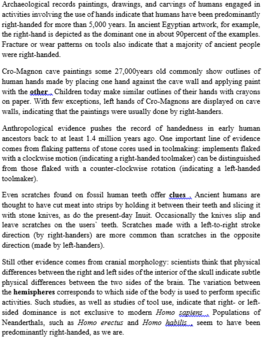Read the following passage and mark the letter A, B, C, or D on your answer sheet to indicate the correct answer to each of the following questions.
Fish that live on the sea bottom benefit by being flat and hugging the contours. There are two very different types of flatfish and they have evolved in very separate ways. The skates and rays, relatives of the sharks, have become flat in what might be called the obvious way. Their bodies have grown out sideways to form great “wings”. They look as though they have been flattened but have remained symmetrical and “the right way up”. Conversely, fish such as plaice, sole, and halibut have become flat in a different way. There are bony fish which have a marked tendency to be flattened in a vertical direction; they are much “taller” then they are wide. They use their whole, vertically flattened bodies as swimming surfaces, which undulate through the water as they move. Therefore, when their ancestors migrated to the seabed, they lay on one side than on their bellies. However, this raises the problem that one eye was always looking down into the sand and was effectively useless – In evolution this problem was solved by the lower eye “moving” around the other side. We see this process of moving around enacted in the development of every young bony flatfish. It starts life swimming near the surface, and is symmetrical and vertically flattened, but then the skull starts to grow in a strange asymmetrical twisted fashion, so that one eye, for instance the left, moves over the top of the head upwards, and old Picasso – like vision. Incidentally, some species of 20 flatfish settle on the right side, others on the left, and others on either side.
The author mentions skates and rays as examples of fish that _______.
A. become asymmetrical
B. appear to fly
C. have spread horizontally
D. resemble sharks




Đáp án C.
Key words: skates and rays, examples.
Clue: The skates and rays, relatives of the sharks, have become flat in what might be called the obvious way. Their bodies have grown out sideways to form great “wings”. They look as though they have been flattened but have remained symmetrical: Những chiếc giày trượt và cá voi, những người họ hàng của cá mập, đã trở nên dẹt (có thể được gọi một cách rõ ràng. Cơ thể của chúng đã phát triển sang hai bên để tạo thành những bộ “cánh” tuyệt vời. Chúng trông như thể chúng đã được làm phẳng nhưng vẫn giữ được đối xứng
Phân tích:
A. become asymmetrical: trở nên xoắn đối – Sai vì loài cá này đối xứng kép.
B. appear to fly: có thể bay – Sai vì những chiếc cánh ở đây để trong ngoặc kép, không phải giống cánh thật.
C. have spread horizontally: trải rộng sang ngang – Đúng. “Spread” là trải rộng dài, bài khóa đề cập đến những chiếc cánh lớn.
D. resemble sharks: trông giống cá mập – Sai vì loài cá đuối này chỉ có họ hàng với cá mập, ngoại hình của chúng không giống cá mập.
Vậy câu trả lời đúng là C. have spread horizontally